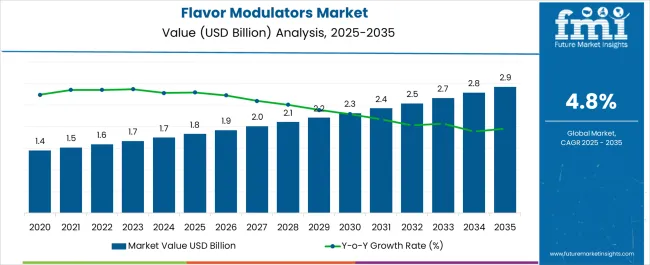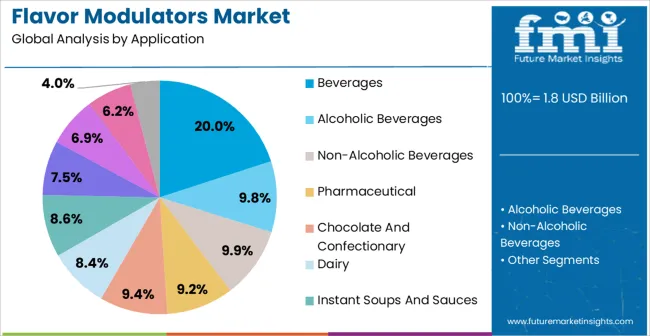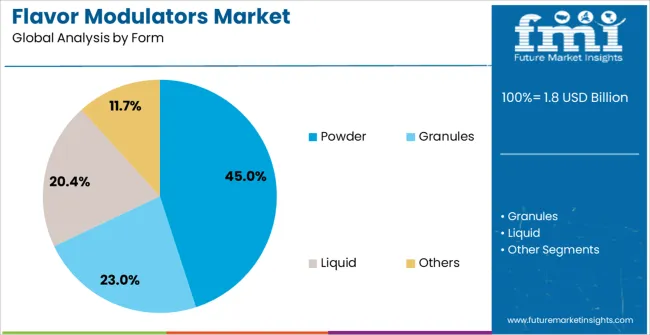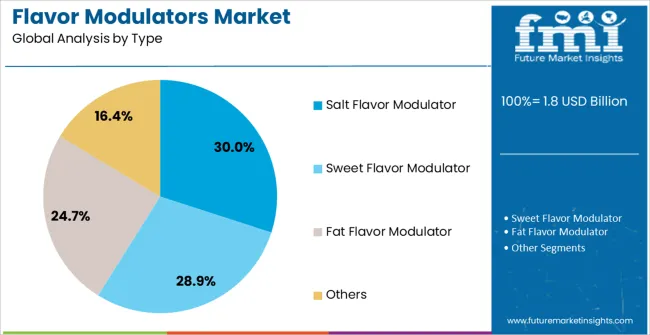The Flavor Modulators Market is estimated to be valued at USD 1.8 billion in 2025 and is projected to reach USD 2.9 billion by 2035, registering a compound annual growth rate (CAGR) of 4.8% over the forecast period.

| Metric | Value |
|---|---|
| Flavor Modulators Market Estimated Value in (2025 E) | USD 1.8 billion |
| Flavor Modulators Market Forecast Value in (2035 F) | USD 2.9 billion |
| Forecast CAGR (2025 to 2035) | 4.8% |
The Flavor Modulators market is experiencing steady growth driven by increasing consumer demand for enhanced taste experiences across food and beverage products. The market is being shaped by the growing preference for low-sodium, low-sugar, and functional foods where flavor enhancement without additional ingredients is critical.
Innovation in formulation technology and the ability to selectively enhance, suppress, or balance specific taste attributes are enabling food and beverage manufacturers to meet evolving consumer expectations. Rising health consciousness among consumers, combined with an increasing focus on clean-label products, has supported the adoption of flavor modulators across multiple categories.
Additionally, the market is benefiting from investment in research and development, particularly in flavor modulation for beverages and processed foods, which allows for the creation of products that deliver improved sensory experiences without compromising nutritional goals As demand for functional and health-focused food products continues to expand, flavor modulators are anticipated to remain a key ingredient innovation, driving growth in both developed and emerging markets globally.
The flavor modulators market is segmented by application, form, type, distribution channel, and geographic regions. By application, flavor modulators market is divided into Beverages, Alcoholic Beverages, Non-Alcoholic Beverages, Pharmaceutical, Chocolate And Confectionary, Dairy, Instant Soups And Sauces, Bakery, Animal Feed, Dietary Supplements, and Others. In terms of form, flavor modulators market is classified into Powder, Granules, Liquid, and Others. Based on type, flavor modulators market is segmented into Salt Flavor Modulator, Sweet Flavor Modulator, Fat Flavor Modulator, and Others. By distribution channel, flavor modulators market is segmented into B2B, B2C, Store-Based Retailing, Grocery Retailers, Modern Grocery Retailers, Convenience Stores, Discounters, Traditional Grocery Retailers, Independent Small Grocers, Other Grocery Retailers, Non-Grocery Retailers, Mixed Retailers, Medical Retailers, Other Non-Grocery Retailers, and Online Retailing. Regionally, the flavor modulators industry is classified into North America, Latin America, Western Europe, Eastern Europe, Balkan & Baltic Countries, Russia & Belarus, Central Asia, East Asia, South Asia & Pacific, and the Middle East & Africa.

The Beverages application segment is projected to hold 20.00% of the Flavor Modulators market revenue share in 2025, making it a leading application area. This dominance is being attributed to the high consumer demand for taste enhancement in beverages without increasing sugar, sodium, or artificial additives.
The segment has benefited from innovation in flavor modulation technologies that allow precise adjustment of sweetness, saltiness, and bitterness to suit diverse consumer preferences. Growth has been accelerated by the rising popularity of functional beverages, ready-to-drink drinks, and premium beverages where flavor consistency and sensory experience are critical.
The ability to integrate modulators into existing formulations without significant changes in processing or stability has further enhanced adoption As beverage manufacturers continue to prioritize health-conscious formulations alongside taste appeal, the Beverages segment is expected to maintain a strong revenue contribution, supported by the flexibility and effectiveness of flavor modulators in enhancing consumer satisfaction.

The Powder form is expected to account for 45.00% of the Flavor Modulators market revenue share in 2025, emerging as the leading form factor. This preference is being driven by the ease of handling, storage stability, and compatibility with a wide range of dry and reconstituted products.
Powdered modulators allow for precise dosing, consistent flavor delivery, and seamless integration into manufacturing processes without altering product texture or quality. Adoption has been further supported by applications in beverages, snacks, and seasoning mixes where uniformity and shelf life are critical.
The Powder form also facilitates cost-effective logistics and flexible packaging, which has enhanced its appeal among manufacturers As the demand for convenience foods and ready-to-use formulations grows, powder flavor modulators are anticipated to continue leading the market, offering scalable, stable, and versatile solutions for diverse applications.

The Salt Flavor Modulator type segment is projected to hold 30.00% of the Flavor Modulators market revenue share in 2025, making it the leading type in the market. This position has been driven by increasing consumer awareness about the health risks associated with high sodium intake and the demand for low-sodium products that do not compromise on taste.
Salt flavor modulators are enabling manufacturers to maintain the desired salty taste while significantly reducing sodium content, thereby meeting regulatory requirements and health-conscious consumer expectations. Adoption has been accelerated across processed foods, snacks, and beverages where salt reduction is a priority.
The ability to achieve flavor optimization without impacting overall product quality or mouthfeel has reinforced growth As public health initiatives and nutritional guidelines continue to emphasize sodium reduction, the Salt Flavor Modulator segment is expected to sustain leadership, supported by ongoing innovation and wide applicability across food and beverage categories.
In the food and beverage sector, flavor modulators play a crucial role. These ingredients are vital in increasing the flavor and scent of goods and developing novel flavor combinations that draw in customers. Flavor modulators can alter or improve the perception of several flavors and scent attributes, including sweet, salty, bitter, sour, and umami, by interacting with the sensory receptors in our taste buds and olfactory system.
Modulators that change flavor are crucial parts of the food and beverage business. These elements are essential for developing novel flavor combinations, cutting down on the need for salt and sugar, and improving the sensory experience of products. Manufacturers can develop goods that satisfy consumers' shifting tastes and health requirements by studying the various flavor modulators and how they work.
In our new study, ESOMAR-certified market research and consulting firm Future Market Insights (FMI) offers insights into key factors driving demand for Flavor Modulators.

| Country | CAGR |
|---|---|
| China | 6.5% |
| India | 6.0% |
| Germany | 5.5% |
| Brazil | 5.0% |
| USA | 4.6% |
| UK | 4.1% |
| Japan | 3.6% |
The Flavor Modulators Market is expected to register a CAGR of 4.8% during the forecast period, exhibiting varied country level momentum. China leads with the highest CAGR of 6.5%, followed by India at 6.0%. Developed markets such as Germany, France, and the UK continue to expand steadily, while the USA is likely to grow at consistent rates. Japan posts the lowest CAGR at 3.6%, yet still underscores a broadly positive trajectory for the global Flavor Modulators Market. In 2024, Germany held a dominant revenue in the Western Europe market and is expected to grow with a CAGR of 5.5%. The USA Flavor Modulators Market is estimated to be valued at USD 644.9 million in 2025 and is anticipated to reach a valuation of USD 644.9 million by 2035. Sales are projected to rise at a CAGR of 0.0% over the forecast period between 2025 and 2035. While Japan and South Korea markets are estimated to be valued at USD 99.2 million and USD 53.7 million respectively in 2025.

| Item | Value |
|---|---|
| Quantitative Units | USD 1.8 Billion |
| Application | Beverages, Alcoholic Beverages, Non-Alcoholic Beverages, Pharmaceutical, Chocolate And Confectionary, Dairy, Instant Soups And Sauces, Bakery, Animal Feed, Dietary Supplements, and Others |
| Form | Powder, Granules, Liquid, and Others |
| Type | Salt Flavor Modulator, Sweet Flavor Modulator, Fat Flavor Modulator, and Others |
| Distribution Channel | B2B, B2C, Store-Based Retailing, Grocery Retailers, Modern Grocery Retailers, Convenience Stores, Discounters, Traditional Grocery Retailers, Independent Small Grocers, Other Grocery Retailers, Non-Grocery Retailers, Mixed Retailers, Medical Retailers, Other Non-Grocery Retailers, and Online Retailing |
| Regions Covered | North America, Europe, Asia-Pacific, Latin America, Middle East & Africa |
| Country Covered | United States, Canada, Germany, France, United Kingdom, China, Japan, India, Brazil, South Africa |
| Key Companies Profiled | Givaudan, DSM, Kerry Group, Ingredion, Symrise, Sensient Technologies, Firmenich, International Flavors & Fragrances, and Guangdong Zhaoqing Flavor Factory |
The global flavor modulators market is estimated to be valued at USD 1.8 billion in 2025.
The market size for the flavor modulators market is projected to reach USD 2.9 billion by 2035.
The flavor modulators market is expected to grow at a 4.8% CAGR between 2025 and 2035.
The key product types in flavor modulators market are beverages, alcoholic beverages, non-alcoholic beverages, pharmaceutical, chocolate and confectionary, dairy, instant soups and sauces, bakery, animal feed, dietary supplements and others.
In terms of form, powder segment to command 45.0% share in the flavor modulators market in 2025.






Our Research Products

The "Full Research Suite" delivers actionable market intel, deep dives on markets or technologies, so clients act faster, cut risk, and unlock growth.

The Leaderboard benchmarks and ranks top vendors, classifying them as Established Leaders, Leading Challengers, or Disruptors & Challengers.

Locates where complements amplify value and substitutes erode it, forecasting net impact by horizon

We deliver granular, decision-grade intel: market sizing, 5-year forecasts, pricing, adoption, usage, revenue, and operational KPIs—plus competitor tracking, regulation, and value chains—across 60 countries broadly.

Spot the shifts before they hit your P&L. We track inflection points, adoption curves, pricing moves, and ecosystem plays to show where demand is heading, why it is changing, and what to do next across high-growth markets and disruptive tech

Real-time reads of user behavior. We track shifting priorities, perceptions of today’s and next-gen services, and provider experience, then pace how fast tech moves from trial to adoption, blending buyer, consumer, and channel inputs with social signals (#WhySwitch, #UX).

Partner with our analyst team to build a custom report designed around your business priorities. From analysing market trends to assessing competitors or crafting bespoke datasets, we tailor insights to your needs.
Supplier Intelligence
Discovery & Profiling
Capacity & Footprint
Performance & Risk
Compliance & Governance
Commercial Readiness
Who Supplies Whom
Scorecards & Shortlists
Playbooks & Docs
Category Intelligence
Definition & Scope
Demand & Use Cases
Cost Drivers
Market Structure
Supply Chain Map
Trade & Policy
Operating Norms
Deliverables
Buyer Intelligence
Account Basics
Spend & Scope
Procurement Model
Vendor Requirements
Terms & Policies
Entry Strategy
Pain Points & Triggers
Outputs
Pricing Analysis
Benchmarks
Trends
Should-Cost
Indexation
Landed Cost
Commercial Terms
Deliverables
Brand Analysis
Positioning & Value Prop
Share & Presence
Customer Evidence
Go-to-Market
Digital & Reputation
Compliance & Trust
KPIs & Gaps
Outputs
Full Research Suite comprises of:
Market outlook & trends analysis
Interviews & case studies
Strategic recommendations
Vendor profiles & capabilities analysis
5-year forecasts
8 regions and 60+ country-level data splits
Market segment data splits
12 months of continuous data updates
DELIVERED AS:
PDF EXCEL ONLINE
Flavor Modulator Market Size and Share Forecast Outlook 2025 to 2035
Flavor Emulsions Market Size and Share Forecast Outlook 2025 to 2035
Flavor Masking Agents Market Size and Share Forecast Outlook 2025 to 2035
Flavor Compounds Market Size and Share Forecast Outlook 2025 to 2035
Flavoring Cosmetic Formulation Agents Market Size and Share Forecast Outlook 2025 to 2035
Flavored Whiskey Market Size and Share Forecast Outlook 2025 to 2035
Flavored Butter And Oils Market Size and Share Forecast Outlook 2025 to 2035
Flavoring Oils Market Size and Share Forecast Outlook 2025 to 2035
Flavoring Agents Market Size and Share Forecast Outlook 2025 to 2035
Flavors for Pharmaceutical & Healthcare Applications Market Size and Share Forecast Outlook 2025 to 2035
Flavor Capsule Cigarette Market Analysis - Size, Share, and Forecast 2025 to 2035
Flavored Syrup Market Analysis - Size, Share, and Forecast Outlook 2025 to 2035
Analysis and Growth Projections for Flavor and Flavor Enhancers Market
Flavored Yogurt Market Analysis by Form, Flavor, End Use and Distribution Channel Through 2035
Flavors and Fragrances Market Analysis by Type, Nature, Application, and Region through 2035
Flavor Emulsion Market Analysis by Nature, End-Use, Distribution Channel, and Region - Growth, trends and forecast from 2025 to 2035
Flavored CBD Powder Market Growth - Innovations & Consumer Trends 2025 to 2035
Flavored Salt Market Insights - Seasoning Trends & Growth 2025 to 2035
Flavored Water Market Trends - Hydration & Wellness Demand 2025 to 2035
Flavor Drops Market Growth - Beverage & Functional Trends 2025 to 2035

Thank you!
You will receive an email from our Business Development Manager. Please be sure to check your SPAM/JUNK folder too.
Chat With
MaRIA